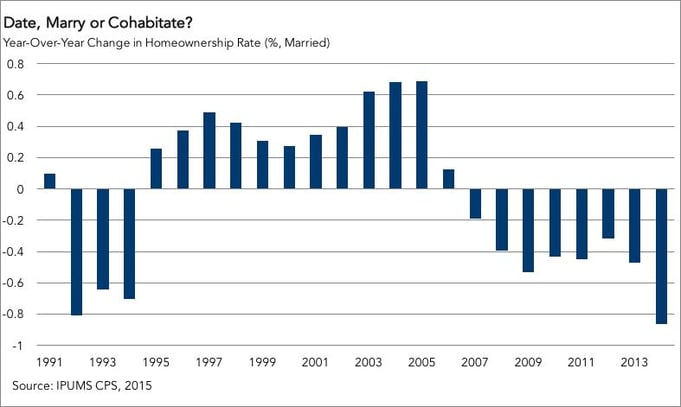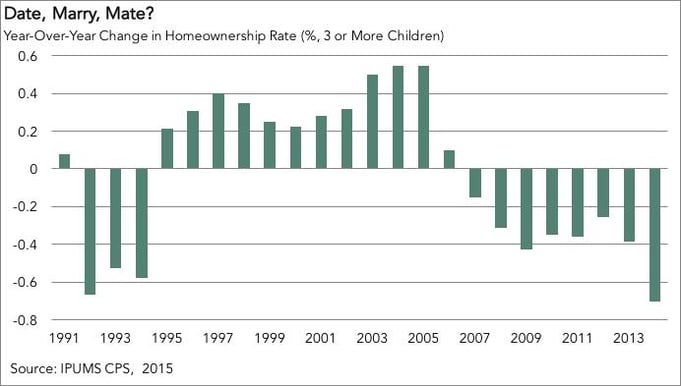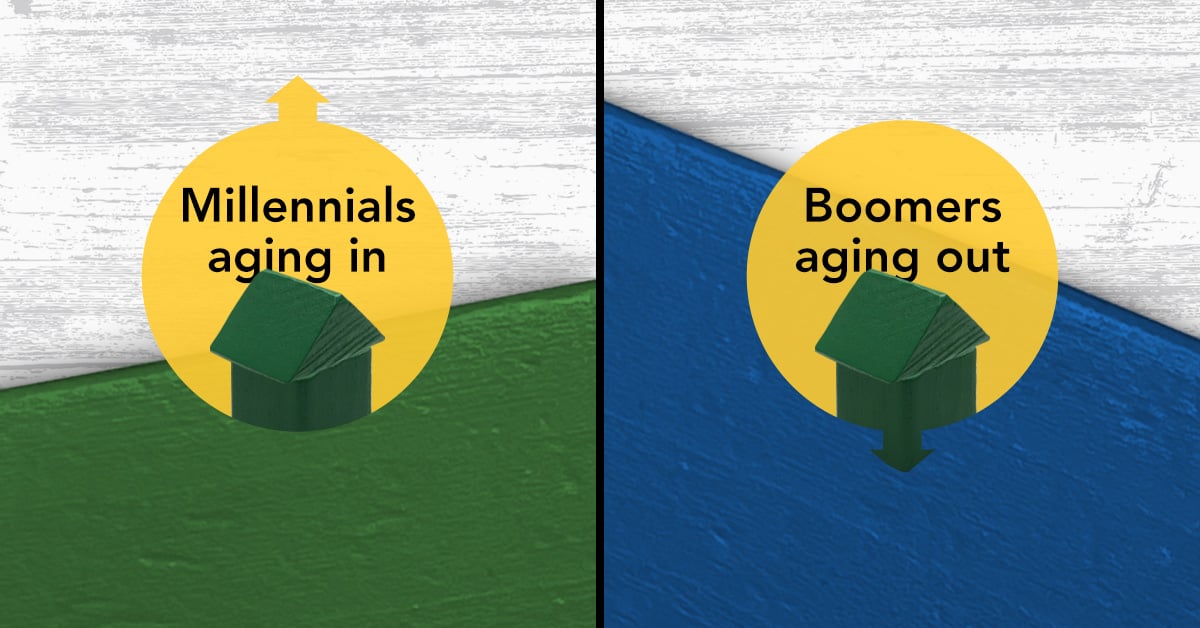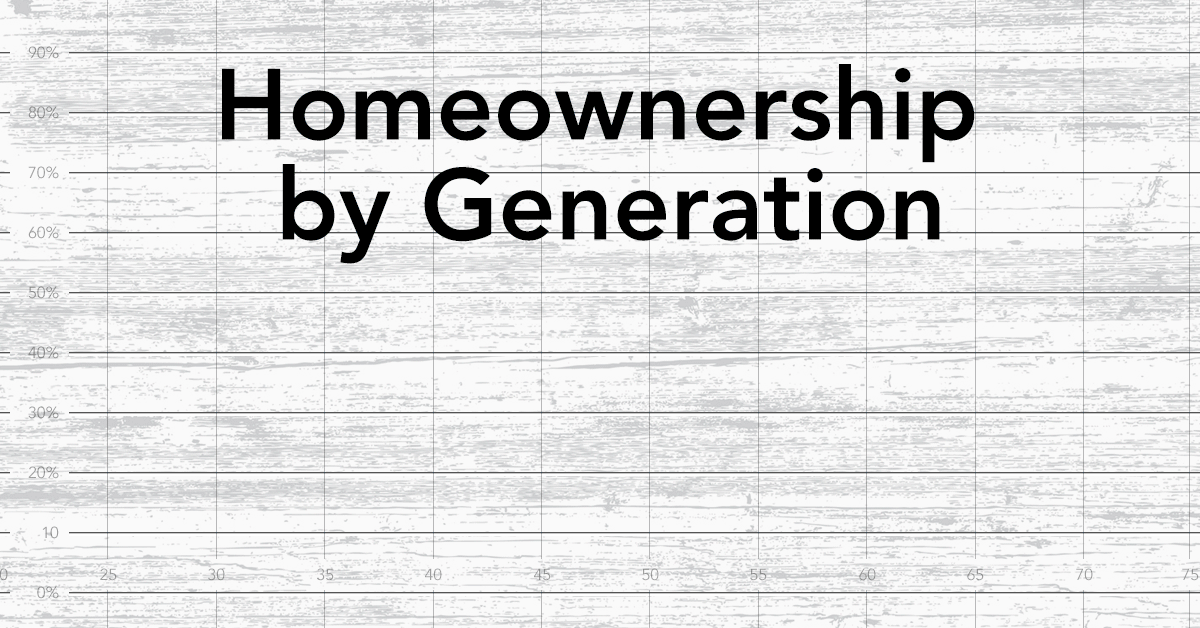For Valentine’s Day, we pondered the question, could more love lead to an increase in homeownership? This is a serious question because marriage and homeownership, perhaps the two most enduring institutions of our society, have shaped the economic fortunes of many Americans.
Imagine for a moment the quintessential image of the American Dream. Chances are the image in your mind’s eye includes a house and a family. And for good reason, as homeownership has long been associated with the American Dream, partially because it is considered a key component of economic well-being.
“If we give love time, as Millennials age, we may see an increase in the share of married households with children, and a corresponding increase in homeownership.”
But, the overall homeownership rate has fallen from a peak of 69 percent in 2004 to approximately 63.7 percent in 2015, a 5.3 percent decline. Has homeownership lost its place as part of the American Dream? Far from it. Surveys consistently indicate that the desire for homeownership remains high. So, what could be causing the decline in homeownership, and where does love fit in?
Date, Marry or Cohabitate?
Let’s consider marriage a proxy for love. Over the last half century, there has been an overall decline in the rate of marriage. According to government data, the share of married households has fallen from a high of 72 percent in 1960 to approximately 50 percent today.
Have Americans lost that loving feeling? Many reasons are cited for the decline in the rate of marriage, including the increase in the participation of women in the labor force, changing gender roles within marriage, and an increased level of educational attainment. Most recently, we’ve seen Millennials largely prioritize higher educational attainment over marriage. The share of young adults (aged 24-to-34) that have been married has dropped from 70 percent in 1995 to 54 percent in 2014. In a recent Washington Post article, Millennials were quoted as saying they view marriage as a financial commitment, and that they wouldn’t feel comfortable entering this stage of their lives while carrying student loan debt and before securing steady employment. Instead, Millennials often opt for cohabitation with their partners in a rental unit.
According to analysis in our Homeownership Progress Index (HPRI), the homeownership rate is 30 percent higher among married couples than other households. If married households are more likely to be homeowners, and marital rates are falling, how much of the decline in homeownership is due to the changing attitudes toward marriage, our proxy for love?
Figure 1 shows the correlation between the change in the homeownership rate and the change in the rate of marriage, when all other lifestyle and demographic factors are held equal [1]. Because the marriage rate was increasing between 1995 and 2005 as Generation X got hitched, marriage was a net contributor to the growing overall homeownership rate, but from 2005 to 2014 the declining marriage rate alone has reduced the homeownership rate by 3.5 percentage points.
Figure 1

Date, Marry, Multiply?
Another way our proxy for love, marriage, connects to homeownership is the decision to have children. A recent study by the Urban Institute found that between 2007 and 2012 birth rates among women in their twenties declined by more than 15 percent. The drop was, in part, caused by the decline in the rate of marriage. This doesn’t necessarily suggest that either the marriage rate or birth rates won’t increase as Millennials choose to have children at a later age, but it does delay the decision to buy a home.
In our analysis, we find that just as the decision to marry influences the decision to own, so does the decision to have children. As one might suspect, the more children in a household, the more likely the household will decide to own versus rent. The homeownership rate is 1.7 percent higher for households with one or two children compared to households with no children, it is 5.4 percent higher for households with three or more children.
Figure 2 shows, all other factors being equal, the change in the homeownership rate over time when correlated with the change in the number of households with three or more children. Similar to the influence of marriage on homeownership, as the number of households with three or more children increased from 1995 to 2006, the homeownership rate also increased. Since then, the declining number of households with children has driven the homeownership rate down. In fact, from 2006 to 2014 the homeownership rate declined 2.9 percent due to the decline in the number of households with three or more children.
Figure 2

Date, Marry, Multiply and Buy
Is the American Dream of homeownership dead, or is it responding to changes in the lifestyle decisions being made by young adults today? Changing preferences to marriage and children, specifically delaying these important lifestyle choices, are important reasons why we see lower homeownership rates today than in the past half century.
This doesn’t mean the desire is gone. In fact, a case could be made that policies that encourage marriage (our proxy for love) and having children would increase homeownership. Yet, that may not be necessary. If we give love time, as Millennials age, we may see an increase in the share of married households with children, and a corresponding increase in homeownership.
[1] Our analysis fixes all the other influences on the homeownership rate at their historical mean: Bachelors degree educated white male head of household making $60,000 per year at 35 years old.



